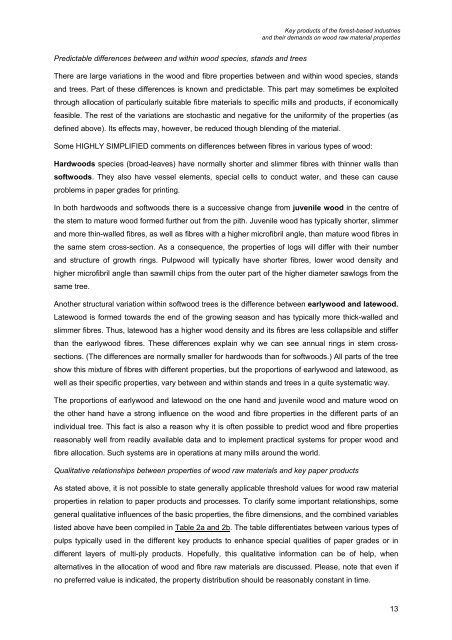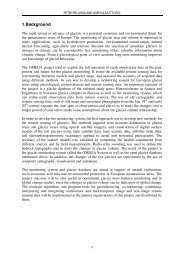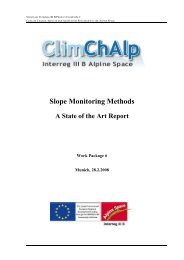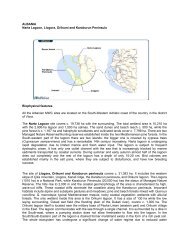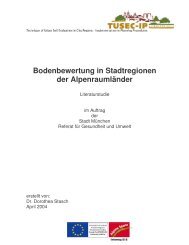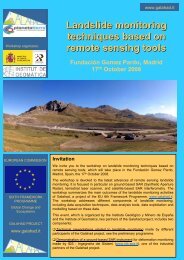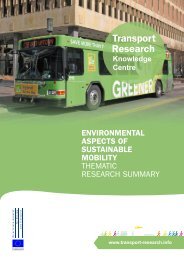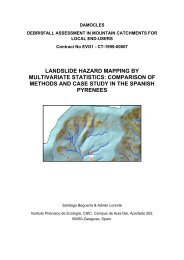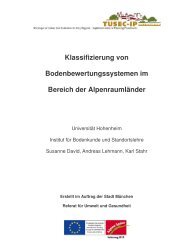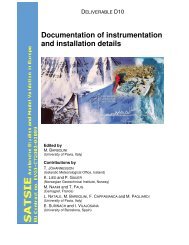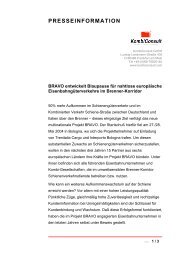Deliverable D3.1.2 Key products of the forest-based industries and ...
Deliverable D3.1.2 Key products of the forest-based industries and ...
Deliverable D3.1.2 Key products of the forest-based industries and ...
Create successful ePaper yourself
Turn your PDF publications into a flip-book with our unique Google optimized e-Paper software.
<strong>Key</strong> <strong>products</strong> <strong>of</strong> <strong>the</strong> <strong>forest</strong>-<strong>based</strong> <strong>industries</strong><strong>and</strong> <strong>the</strong>ir dem<strong>and</strong>s on wood raw material propertiesPredictable differences between <strong>and</strong> within wood species, st<strong>and</strong>s <strong>and</strong> treesThere are large variations in <strong>the</strong> wood <strong>and</strong> fibre properties between <strong>and</strong> within wood species, st<strong>and</strong>s<strong>and</strong> trees. Part <strong>of</strong> <strong>the</strong>se differences is known <strong>and</strong> predictable. This part may sometimes be exploitedthrough allocation <strong>of</strong> particularly suitable fibre materials to specific mills <strong>and</strong> <strong>products</strong>, if economicallyfeasible. The rest <strong>of</strong> <strong>the</strong> variations are stochastic <strong>and</strong> negative for <strong>the</strong> uniformity <strong>of</strong> <strong>the</strong> properties (asdefined above). Its effects may, however, be reduced though blending <strong>of</strong> <strong>the</strong> material.Some HIGHLY SIMPLIFIED comments on differences between fibres in various types <strong>of</strong> wood:Hardwoods species (broad-leaves) have normally shorter <strong>and</strong> slimmer fibres with thinner walls thans<strong>of</strong>twoods. They also have vessel elements, special cells to conduct water, <strong>and</strong> <strong>the</strong>se can causeproblems in paper grades for printing.In both hardwoods <strong>and</strong> s<strong>of</strong>twoods <strong>the</strong>re is a successive change from juvenile wood in <strong>the</strong> centre <strong>of</strong><strong>the</strong> stem to mature wood formed fur<strong>the</strong>r out from <strong>the</strong> pith. Juvenile wood has typically shorter, slimmer<strong>and</strong> more thin-walled fibres, as well as fibres with a higher micr<strong>of</strong>ibril angle, than mature wood fibres in<strong>the</strong> same stem cross-section. As a consequence, <strong>the</strong> properties <strong>of</strong> logs will differ with <strong>the</strong>ir number<strong>and</strong> structure <strong>of</strong> growth rings. Pulpwood will typically have shorter fibres, lower wood density <strong>and</strong>higher micr<strong>of</strong>ibril angle than sawmill chips from <strong>the</strong> outer part <strong>of</strong> <strong>the</strong> higher diameter sawlogs from <strong>the</strong>same tree.Ano<strong>the</strong>r structural variation within s<strong>of</strong>twood trees is <strong>the</strong> difference between earlywood <strong>and</strong> latewood.Latewood is formed towards <strong>the</strong> end <strong>of</strong> <strong>the</strong> growing season <strong>and</strong> has typically more thick-walled <strong>and</strong>slimmer fibres. Thus, latewood has a higher wood density <strong>and</strong> its fibres are less collapsible <strong>and</strong> stifferthan <strong>the</strong> earlywood fibres. These differences explain why we can see annual rings in stem crosssections.(The differences are normally smaller for hardwoods than for s<strong>of</strong>twoods.) All parts <strong>of</strong> <strong>the</strong> treeshow this mixture <strong>of</strong> fibres with different properties, but <strong>the</strong> proportions <strong>of</strong> earlywood <strong>and</strong> latewood, aswell as <strong>the</strong>ir specific properties, vary between <strong>and</strong> within st<strong>and</strong>s <strong>and</strong> trees in a quite systematic way.The proportions <strong>of</strong> earlywood <strong>and</strong> latewood on <strong>the</strong> one h<strong>and</strong> <strong>and</strong> juvenile wood <strong>and</strong> mature wood on<strong>the</strong> o<strong>the</strong>r h<strong>and</strong> have a strong influence on <strong>the</strong> wood <strong>and</strong> fibre properties in <strong>the</strong> different parts <strong>of</strong> anindividual tree. This fact is also a reason why it is <strong>of</strong>ten possible to predict wood <strong>and</strong> fibre propertiesreasonably well from readily available data <strong>and</strong> to implement practical systems for proper wood <strong>and</strong>fibre allocation. Such systems are in operations at many mills around <strong>the</strong> world.Qualitative relationships between properties <strong>of</strong> wood raw materials <strong>and</strong> key paper <strong>products</strong>As stated above, it is not possible to state generally applicable threshold values for wood raw materialproperties in relation to paper <strong>products</strong> <strong>and</strong> processes. To clarify some important relationships, somegeneral qualitative influences <strong>of</strong> <strong>the</strong> basic properties, <strong>the</strong> fibre dimensions, <strong>and</strong> <strong>the</strong> combined variableslisted above have been compiled in Table 2a <strong>and</strong> 2b. The table differentiates between various types <strong>of</strong>pulps typically used in <strong>the</strong> different key <strong>products</strong> to enhance special qualities <strong>of</strong> paper grades or indifferent layers <strong>of</strong> multi-ply <strong>products</strong>. Hopefully, this qualitative information can be <strong>of</strong> help, whenalternatives in <strong>the</strong> allocation <strong>of</strong> wood <strong>and</strong> fibre raw materials are discussed. Please, note that even ifno preferred value is indicated, <strong>the</strong> property distribution should be reasonably constant in time.13


